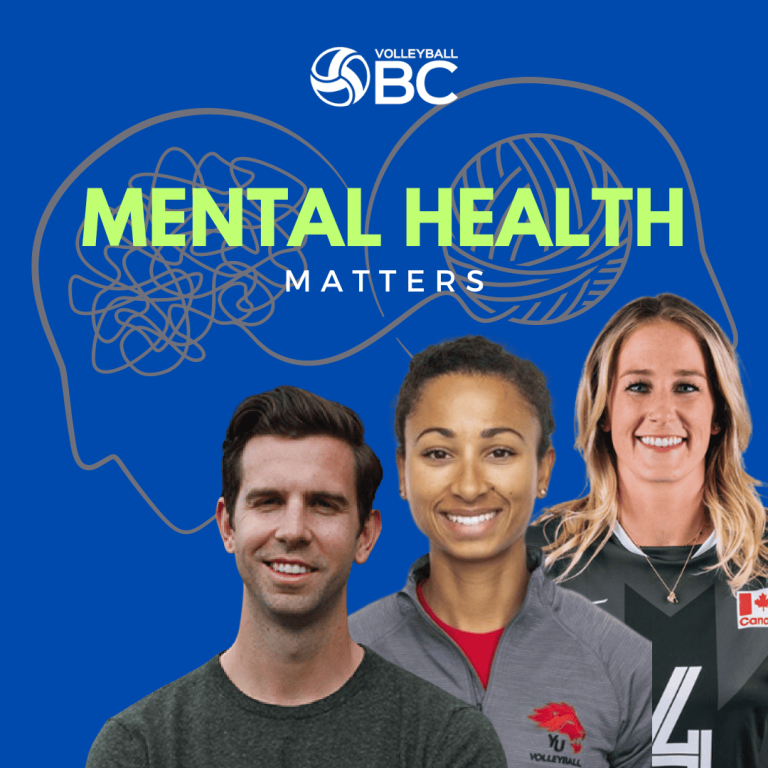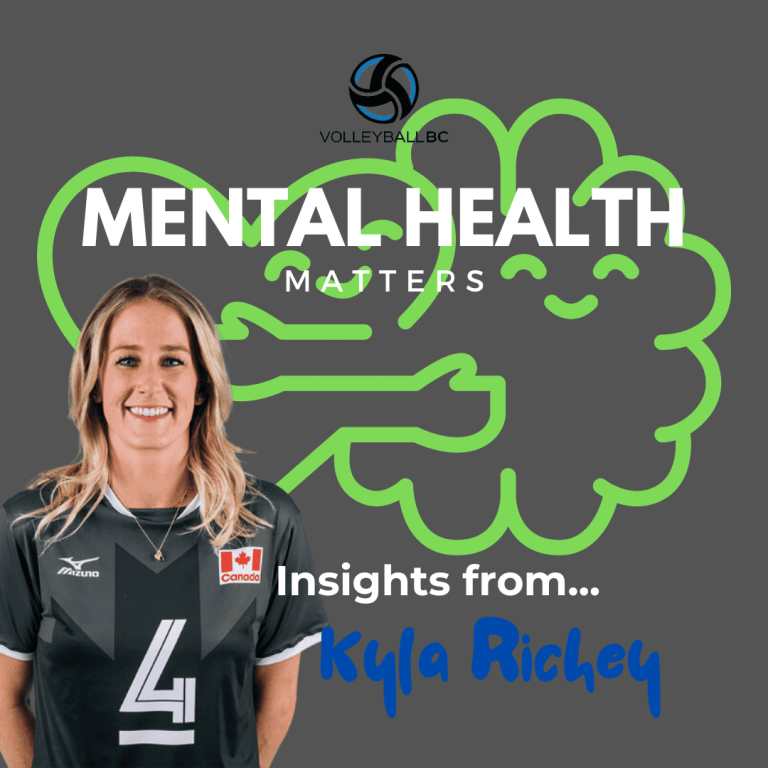Mental Health and Well-Being

Sport has the power to positively change lives and build communities but it can only do this when the experience places physical, social, and emotional well-being at the very core. Supporting positive mental health is a key component of delivering participant-centred volleyball.
Mental Health is a state of well-being in which every individual realises his or her own potential, can cope with the normal stresses of life, can perform productively, and is able to make a contribution to their (sporting) community.
In our member surveys, we consistently hear about the importance of positive mental health and well-being. Welcome to this page where we showcase some of our resources….
"Maintaining positive mental health and well-being is crucial to all aspects of life in and out of sport. It can be difficult if we only recognize ourselves as 'volleyball players'. It can help unlock a better athletic version of ourselves when our mental and emotional health is prioritized"
Shanice Marcelle, Mental Health Ambassador & Beach Volleyball Player Tweet
the Mental Health toolkit
In October 2023, Volleyball BC launched a Mental Health Toolkit that included practical information across 6 key pillars.
Each element of the toolkit can be digested individually or as a whole. The emphasis is practical tools which key influencers – parents, coaches, officials, administrators, and athletes – can use in order to affect positive change and provide an environment of well-being and positive performance.
I am starting out, where do I begin?
- We have some useful first steps in the “Introduction” section of the toolkit.
- We also have a webinar that you can watch to walk you through different elements of the toolkit.
- Excerpts from the toolkit are available below. The full version of the Mental Health Toolkit is available to volleyball clubs, organisations, and programs that are members of Volleyball BC. For a copy please contact members@volleyballbc.org
Toolkit Excerpts
B5. Inclusive, Diverse and Welcoming Spaces – Introduction
B6. Building Your Network – Introduction
C. Navigation Tools – Abridged Version for Website
D. Webinars:
- Introduction to the toolkit – Dr. Shaunna Taylor and Emma Gibbons
- Managing Performance Anxiety – Dr. Shaunna Taylor
- Creating Positive Team Dynamics – Dr. Shaunna Taylor, Kyla Richey, Shanice Marcelle, and Derek Thiessen
- Cultivating Positive Body Image – Dr. Shaunna Taylor, Kyla Richey, Shanice Marcelle, and Derek Thiessen
- Self Care for Mental Well-being in Volleyball – Dr. Shaunna Taylor, Shanice Marcelle and Derek Thiessen

looking for a specific mental health topic?
Performance Anxiety – athletes
WEBINAR: Managing Performance Anxiety– Dr. Shaunna Taylor
WEBINAR: Mental Preparation for Performance – Dr. Shaunna Taylor, Shanice Marcelle, and Derek Thiessen
WEBINAR: Preparing Athletes for Provincial Championships – Coach webinar on Mental Skill Preparation – Dr. Shaunna Taylor, Shanice Marcelle, and Derek Thiessen
Body image and disordered eating
WEBINAR: Cultivating Positive Body Image– Dr. Shaunna Taylor, Kyla Richey, Shanice Marcelle, and Derek Thiessen
Athlete self-care and stress reduction.
Activity Card – Mood Music Exercise
WEBINAR: Self Care for Mental Well-being in Volleyball – Dr. Shaunna Taylor, Shanice Marcelle and Derek Thiessen
WEBINAR: Creating Positive Team Dynamics – Dr. Shaunna Taylor, Kyla Richey, Shanice Marcelle, and Derek Thiessen
WEBINAR: Creating Positive Team Dynamics and Relationships (Athletes and Parents) – Dr. Shaunna Taylor and Kyla Richey
WEBINAR: Creating Positive Team Dynamics (Coaches) – Dr. Shaunna Taylor and Ryan Adams
WEBINAR: Coping with Injuries – Mental Pathways to Recover (Athletes and Parents) – Dr. Shaunna Taylor, Kyla Richey and Derek Thiessen
WEBINAR: Supporting Athletes Through Injury (Coaches) – Dr. Shaunna Taylor, Kyla Richey and Derek Thiessen
Meet our Mental Health Ambassadors

PRO BEACH VOLLEYBALL PLAYER AND POST-SECONDARY COACH
“Through time I have developed a few different strategies to help me daily and other strategies to help me through more difficult moments. I don’t think there is a one way fits all approach and want to acknowledge that sometimes it takes a bit of trial and error to discover what works best for you as an individual. The 2 strategies that work best for me are to take to writing – whether it is journalling daily, or writing something more formal, and to focus on my breathing. I find putting my words and thoughts and emotions to paper helps me see things more clearly and is often a way to release when things become overwhelming. And breathing, when we learn to control it, can help bring our bodies and minds to a place of ease. “

FORMER CAPTAIN OF THE WOMEN'S NATIONAL TEAM
“I was fortunate enough to have access to a therapist ever since I joined Team Canada back in 2008. After going through a lot of personal trauma (such as losing my brother in 2013), I knew it was necessary to seek external resources if I were to continue playing volleyball. Therapists/counsellors/sports psychologists over the years, gave me tools that I could utilize in countless situations, both on and off the court. My family and teammates also played an invaluable role through my entire volleyball career, from university to Team Canada to professional teams abroad. My support system helped me get through my toughest moments/seasons.”

FORMER POST-SECONDARY VOLLEYBALL ATHLETE & COACH
“Looking back on my time as an athlete, I can see how the quality of my mental well-being often influenced my performance in volleyball. Sometimes, we like to think that sports and life are separate enough domains that they don’t impact one another. However, in my experience, I found that when I felt stressed, overwhelmed, and/or depressed in life (whether from school, relationships, or something else), it would find a way to show up in training or competition. Yes, sports can be a healthy way to work through some of our stress and even blow off a little steam. However, I often found that if I did not address the underlying issues, it affected aspects of myself such as my confidence, self-esteem, focus, and passion for the game. In sports, we spend a lot of time focusing on developing the capacity of our body and increasing the skills we have in our craft, but we rarely seem to address the mind. I only realized this after I quit playing volleyball and now see it as such a crucial part of my ability to perform, not only in sports but also in life.”

UBC WOMEN'S TEAM PLAYER & TEAM CANADA BEACH VOLLEYBALL PLAYER
“As a varsity athlete for UBC and a beach volleyball player for Team Canada, my passion for the sport takes over many aspects of my life. Whether it is time spent training, social groups, nutrition, sleep, recovery, I center my actions around my athletic goals and aspirations. Although this can serve me well athletically, it is equally important to take into account other factors that bring me joy in order to address my mental health needs. Some of the ways I practice positive mental health self-care include spending time with my puppy, Milo, engaging in outdoor activities such as paddling boarding, biking or nature walks and catching as many sunsets as I can. These activities allow me to slow down the fast paced, scheduled routines and be mindful of the here and now.”
Tips For Players
Step up has these tips for how you can speak to a team mate or friend if you notice that they are behaving differently and you are concerned about them:
Be curious/ask questions to understand from their point of view.
Ask permission if the topic is sensitive.
Avoid gossiping and rumor spreading.
Take care of yourself — it can be difficult on helpers as well.
Tell someone if you believe that the individual is in danger from themselves or from/to others.
If you or the individual are minors, find an appropriate and responsible adult to get help and support.
Tips For Coaches
Volleyball organisations and coaches play an important role in creating and fostering a culture that recognises the psychological wellbeing of athletes and encourages help-seeking behaviors. Coaches can be the first point of contact for a player to express their feelings. When athletes come to you in emotional distress and they do not present an immediate threat to the safety of themselves or others:
DEMONSTRATE COMPASSION – Some helpful tips for calming the individual and demonstrating compassion are:
Remaining calm yourself — maintain calm body language and tone of voice.
Listen to the individual. Allow them to express their thoughts in a forum where they can be heard.
Avoid judging the individual. You do not have to solve his/her problem. Normalize the experience and offer hope.
GATHER INFORMATION – Ask questions, including questions of safety (“Are you thinking of hurting yourself?” and “Are you thinking of suicide?”). Triage the severity of the situation to determine if the issue can be managed or requires professional support. Professional support should be sought in any instance when you do not feel adequately equipped to manage the situation, and when the athlete is an immediate risk to themselves and/or others.
CONNECT WITH SUPPORT – Present the individual with options for next steps. Connect the athlete to the appropriate support resources if you have them within your organisation or refer them to external organisations if needed. If the individual is a minor, contact their family or appropriate agencies.
RESPECT BOUNDARIES AND ABILITIES – Know what you’re comfortable doing and what you’re not comfortable doing. Don’t promise secrecy. If necessary, you can say, “It took courage for you to disclose this information to me. And, by telling me, it says you want to do something about what is going on. The best thing we can do is to inform someone else, such as a mental health provider, who can give you the care you need.”
DON’T FORGET THE FOLLOW UP – Respect and maintain the athlete’s confidentiality. These are sensitive topics and should be handled as such. Keep the athlete engaged with the team (e.g., invite, but do not force athletes to attend practices, games, team social events, etc.). Follow-up with the athlete on a regular basis. Be flexible with sport-related demands, such as training times, to accommodate any needs. Be patient and sensitive to the fact that dealing with distress takes time, similar to physical injuries.
Additional Resources: Talking to Teens about Mental Health
Seeking Support
Speak to a health professional to find out about resources and strategies to handle what you are experiencing. There are also many free, confidential, and easy-to-use resources that you can access for help and support:
- Kids Help Phone – Text Services: Text “CONNECT” to 686868 or Chat Services
- Crisis Services Canada – Suicide Prevention Service: 1-833-456-4566 (available 24/7)
- Canadian Mental Health Association
- Canadian Centre for Mental Health and Sport
- Headsupguys.org
- England Institute of Sport
- Mental Health Strategy for High Performance Sport in Canada
- Talking to Teens about Mental Health – CMHA
